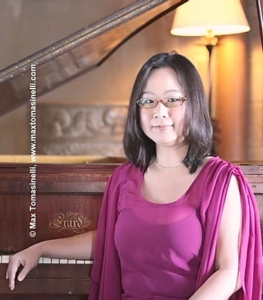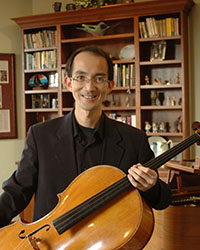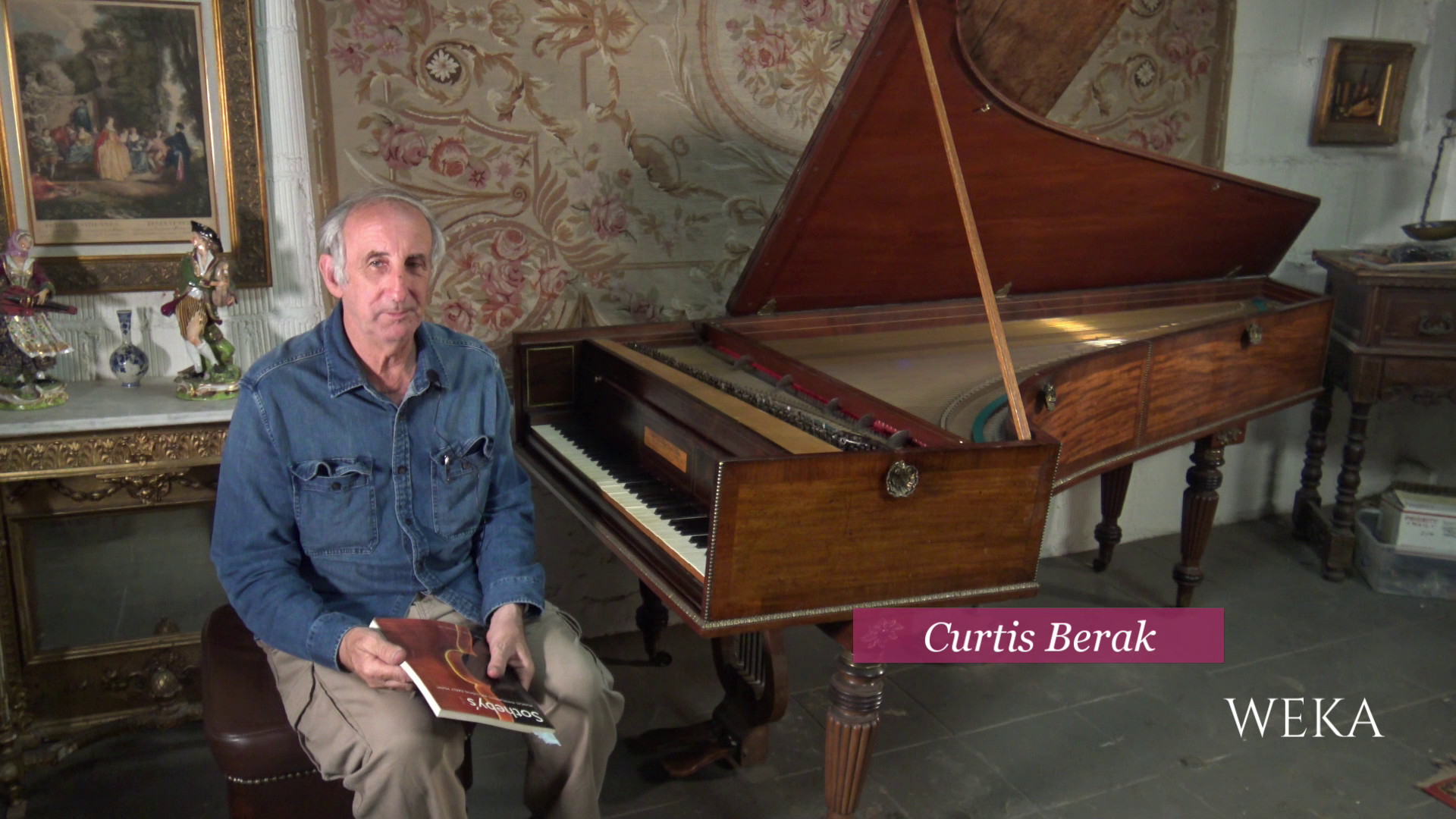Western Early Keyboard Association presents:
BROADWOOD AND THE ROMANTICS:
AN EXPLORATION OF THE FIVE-STRING CELLO
AND THE FORTEPIANO OF THE EARLY 19TH CENTURY
A Video Recital/Demonstration featuring:
Sonia Lee, Broadwood grand pianofortes 1813 and 1829
Ka-Wai Yu, five-string violoncello piccolo
Curtis Berak, early keyboard maker and restorer
PREMIERE ON SUNDAY, JUNE 27, 2021 – 2:00 P.M. [https://youtu.be/qQq2WJZGRck]
On the WEKA YouTube Channel
This intriguing program will include Sonata in A minor for Arpeggione and Piano, D. 821 by Franz Schubert, played on the five-string cello, and other solo keyboard works by Brahms, Liszt and Mendelssohn to showcase two Broadwood fortepianos of 1813 and 1829 owned by Curtis Berak of Los Angeles. Informative interviews with the performers and the owner of the instruments are featured. This is your opportunity to enjoy hearing and learning about these sonorous instruments.
Download a printable program here.
Sonia Lee presented a wonderful program, Sources of Inspiration, for the Western Early Keyboard Association in April 2016, featuring all the instruments in the Reed College Early Keyboard Collection. We are delighted to welcome her back for this performance with Ka-Wai Yu and Curtis Berak.
About the Arpeggione and the Five-String Cello
Schubert’s Sonata D. 821 was written in 1824 for the arpeggione, an instrument developed just the year before. It was a six-stringed, fretted instrument similar to a bass viola da gamba, tuned like the guitar and played with a bow. The instrument soon went out of favor; hence Schubert’s sonata is usually performed on the cello or viola.
In this performance, the sonata will be performed on a five-string cello, also known as violoncello piccolo. This instrument was possibly the five-string instrument that J. S. Bach called for in his Cello Suite No. 6 in D Major with a top E string, similar to the arpeggione. With a wider range thanks to the additional string, the five-string cello is one answer to the common awkwardness of performing this piece on a four-string cello or viola, which otherwise requires frequent shifting and other technical adjustments.
Join us for a ZOOM reception after the premiere.
Spend time with Sonia, Ka-Wai and Curtis to answer your questions and discuss the performance. The link will be available at the premiere.
About Sonia Lee
 Sonia Lee is Editor of the Early Keyboard Journal and the Historical Keyboard Society of North America (HKSNA) Newsletter, and the Immediate Past President of HKSNA. As a performer she has appeared as soloist and collaborative artist on various historical keyboard instruments in nearly 150 cities on four continents. Highlights include the early music festivals of Boston, Costa Rica, Hong Kong, and Utrecht, Rome Festival, Nordic Historical Keyboard Festival, Early Keyboard Music Cycle of Buenos Aires, Milwaukee Museum of the Pianoforte, Handel and Hendrix Museum, Tagliavini Collection at the Museo Colombano, Taipei National Concert Hall, and the Olympus Hall of Seoul. Her discography includes premiere recordings of rediscovered music of Antonia Bembo, Leopold Kozeluch, Thomas Vincent, and Joseph Weigl on the labels Mark Records and Arabesque. She has served as a jury member in various competitions, including the Gianni Gambi International Harpsichord Competition and the Aliénor International Harpsichord Composition Competition. As a writer and scholar, she is an active presenter at conferences, and has contributed articles to Musicians and Composers of the 20th Century, EMAg, and Centaur among others. Dr. Lee holds advanced degrees in music from McGill University and the University of Illinois, and a certificate in public and nonprofit leadership from the Harvard Kennedy School Executive Education. She studied historical piano in masterclasses and workshops with Robert Levin, Andrew Willis, David Breitman, and Malcolm Bilson. She is a resident of Pasadena, California, and has been serving on the board of WEKA since 2016. See https://www.sonialeemusic.com
Sonia Lee is Editor of the Early Keyboard Journal and the Historical Keyboard Society of North America (HKSNA) Newsletter, and the Immediate Past President of HKSNA. As a performer she has appeared as soloist and collaborative artist on various historical keyboard instruments in nearly 150 cities on four continents. Highlights include the early music festivals of Boston, Costa Rica, Hong Kong, and Utrecht, Rome Festival, Nordic Historical Keyboard Festival, Early Keyboard Music Cycle of Buenos Aires, Milwaukee Museum of the Pianoforte, Handel and Hendrix Museum, Tagliavini Collection at the Museo Colombano, Taipei National Concert Hall, and the Olympus Hall of Seoul. Her discography includes premiere recordings of rediscovered music of Antonia Bembo, Leopold Kozeluch, Thomas Vincent, and Joseph Weigl on the labels Mark Records and Arabesque. She has served as a jury member in various competitions, including the Gianni Gambi International Harpsichord Competition and the Aliénor International Harpsichord Composition Competition. As a writer and scholar, she is an active presenter at conferences, and has contributed articles to Musicians and Composers of the 20th Century, EMAg, and Centaur among others. Dr. Lee holds advanced degrees in music from McGill University and the University of Illinois, and a certificate in public and nonprofit leadership from the Harvard Kennedy School Executive Education. She studied historical piano in masterclasses and workshops with Robert Levin, Andrew Willis, David Breitman, and Malcolm Bilson. She is a resident of Pasadena, California, and has been serving on the board of WEKA since 2016. See https://www.sonialeemusic.com
About Ka-Wai Yu
 Ka-Wai Yu was recently promoted as Associate Professor of Music at Dixie State University, Utah, where he teaches cello and string chamber music. Currently the Principal Cellist of the Southwest Symphony Orchestra and a member of the Zion Trio, he has performed as a soloist and chamber musician at numerous important concert venues in Canada, China, Japan, Singapore, South Korea, Taiwan, and the United States. In great demand as a clinician, Yu has given master classes at numerous universities and institutions in North America and Asia, and has taught in music camps and workshops in Illinois, Georgia, Michigan, and Hong Kong.
Ka-Wai Yu was recently promoted as Associate Professor of Music at Dixie State University, Utah, where he teaches cello and string chamber music. Currently the Principal Cellist of the Southwest Symphony Orchestra and a member of the Zion Trio, he has performed as a soloist and chamber musician at numerous important concert venues in Canada, China, Japan, Singapore, South Korea, Taiwan, and the United States. In great demand as a clinician, Yu has given master classes at numerous universities and institutions in North America and Asia, and has taught in music camps and workshops in Illinois, Georgia, Michigan, and Hong Kong.
A founder of the Dixie State University Early Music Festival—established in 2017, Yu has performed with such period-instrument ensembles as Cosmopolitan Baroque, La Réunion Musicale, Concerto Urbano, and Concentus, and has appeared at the American Bach Soloists Academy, Early Music Vancouver Academy, and Boston Early Music Festival Fringe. A past scholarship recipient from the Viola da Gamba Society of America and Early Music America, he studied viola da gamba with Wendy Gillespie, and has worked with historical performance practice specialists Jaap ter Linden, Tanya Tomkins, Elisabeth Reed, Robert Mealy, Wilbert Hazelzet, and Sandra Miller, among others. Yu obtained his Doctor of Musical Arts degree in Cello Performance and Literature from the University of Illinois at Urbana-Champaign, and holds degrees from the Chinese University of Hong Kong and Indiana University’s Jacobs School of Music. See https://music.dixie.edu/music-faculty/ka-wai-yu/
About Curtis Berak
 Curtis Berak, based in Los Angeles, is a multifaceted early keyboard maker and restorer, painter, and an avid hurdy-gurdy player and collector. He is the key go-to person for anything about early keyboards in Southern California and beyond, and has repaired and restored instruments for a long list of owners and institutions. He makes, restores, and decorates instruments both for his own enjoyment and for rental by numerous organizations in the region, including the Los Angeles Philharmonic, Walt Disney Concert Hall, Los Angeles Chamber Orchestra, Musica Angelica, and San Diego Early Music Society. His instruments have been used by numerous renowned historical keyboardists and conductors such as Richard Egarr, Emmanuelle Haïm, Ton Koopman, Nicholas McGegan, Blandine Rannou, Christophe Rousset, Andreas Staier, Melvin Tan, Jory Vinikour, and Glen Wilson. Along with several other North American harpsichord makers, he was recently featured in the article “Instrument Makers with Pluck,” published in the January 2021 issue of the Early Music America Magazine.
Curtis Berak, based in Los Angeles, is a multifaceted early keyboard maker and restorer, painter, and an avid hurdy-gurdy player and collector. He is the key go-to person for anything about early keyboards in Southern California and beyond, and has repaired and restored instruments for a long list of owners and institutions. He makes, restores, and decorates instruments both for his own enjoyment and for rental by numerous organizations in the region, including the Los Angeles Philharmonic, Walt Disney Concert Hall, Los Angeles Chamber Orchestra, Musica Angelica, and San Diego Early Music Society. His instruments have been used by numerous renowned historical keyboardists and conductors such as Richard Egarr, Emmanuelle Haïm, Ton Koopman, Nicholas McGegan, Blandine Rannou, Christophe Rousset, Andreas Staier, Melvin Tan, Jory Vinikour, and Glen Wilson. Along with several other North American harpsichord makers, he was recently featured in the article “Instrument Makers with Pluck,” published in the January 2021 issue of the Early Music America Magazine.
Here’s a review of the performance.